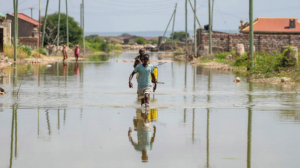Far out in the remote Pacific Ocean, the 2,000 islands of Micronesia were only peopled about 3,500 years ago, archaeological evidence shows. Now we find it didn’t happen quite as had been assumed
Micronesia is defined as a country and has been a much-ballyhooed friend in need for Israel at the United Nations. It actually consists of roughly 2,000 small islands spread over a vast region in the Pacific. Micronesia should not to be confused with the neighboring nations of Polynesia or Melanesia, which also consist of small islands in the Pacific. Now, a new study casts light on the origin of early Micronesians and it is more complicated than had been assumed.
It had been thought that Micronesians shared origins with southwest Pacific peoples, and that Micronesians likely stemmed from a single origin. Now, analysis of ancient and modern Micronesian DNA has detected five separate waves of migration to Micronesia in antiquity: three streams from eastern Asia, one from Polynesia, and one of people related to mainland Papua New Guineans, Yue-Chen Liu and David Reich of Harvard Medical School reported with colleagues last week in Science.
The three streams of “first remote Oceanian” migration into Micronesia included a previously unknown lineage, the team adds.
The study is based on genomic analysis of 164 people who lived 2,800 to 500 years ago at five sites around Micronesia, and 112 genomes of present-day people from the same areas.
“Our results show that people in Micronesia have a diversity of ancestral origins even within the same geographic region, implying that the term ‘Micronesian’ should be used as a geographic label without implying a specific biological profile,” the authors conclude.
Moreover, the new evidence indicates that early Micronesians were matrilocal: the households were centered on the women, while the men would migrate to find mates and would then stay with their new family, the team says.
The sea life
Early humans have been thronging Asia for possibly as much as 2 million years. A hominin species was found at Dmanisi Georgia (the so-called “Homo georgicus”), and some argument rages over what species exactly that was. Meanwhile, anatomically modern humans have been exiting Africa (successfully) for at least 50,000 years and apparently reached the Near Oceania region about 47,000 years ago.
The dates are extremely controversial, especially in the context of Australia, where some argue for an earlier arrival as much as 60,000 years ago by anatomically modern humans – but the proof just isn’t there.
Anyway, one can say that modern types were spreading throughout the region for tens of thousands of years, but apparently they only reached the remote Pacific islands much later.

To reach Micronesia before the aviation age, one had to sail but that wasn’t an obstacle. Some believe that even other human species such as the Neanderthals braved the briny – successfully, that is – based on early human remains on remote islands. Also, the archaeological evidence, supported by linguistics research, suggests that people first reached the vast region of Micronesia roughly 3,500 years ago – very much within the time frame of the sea life.
From where did they come? The genetic analyses and statistical modeling suggests three migrations to Micronesia from people related to present-day populations in the Philippines and Taiwan, including a previously unknown lineage. There was one wave of migration from Polynesia and one from Papua New Guinea.
That last migration seems to have consisted of Papuan men – who did not, it seems, reach Micronesia’s Mariana Archipelago. The predominant ancestry in the Mariana Archipelago appears to be East Asian.
The new paper may even cast light on the development of languages in Micronesia, of which there are many. The CHamoru language spoken on the Mariana islands by the indigenous people, for instance, is a major branch of the Malayo-Polynesian group of tongues, and it also turns out that the CHamoru-speaking peoples have no Papuan ancestry.
Palauan spoken in western Micronesia is another Malayo-Polynesian branch. Then all other Micronesian languages join with tongues of the southwest Pacific and Polynesia to make up a third branch called Central-Eastern Malayo-Polynesian – and from that point it gets complicated.
It also bears adding that things change over time, including within the sphere of Micronesia. “The people of Kapingamarangi and Nukuoro atolls in the Caroline Islands speak Polynesian languages, suggesting replacement of the original languages by Polynesian immigration,” the team points out.
Men at sea
How did the team figure out that ancient Micronesians were matrilocal? It’s wonderful what genetic analysis can tell us these days – Neanderthals among our ancestors, hybrid humans and, most recently, potential prehistoric patrilocality or matrilocality.
Separate work done on Neolithic Britain, also with David Reich, deduced the existence of patrilocality, aka female exogamy: settlements based on the men staying put and “importing” brides from afar.

Apropos the above picture of modern Yappese in a pirogue, their language Yapese is an earlier branching Proto-Oceanic tongue, the researchers say. Possibly therefore the indigenous Yap islanders may have stemmed from a different mixture of source populations than other Central Micronesians.
How exactly can genetic analysis of long-dead people detect prehistoric spousal practices?
Every cell we have (except red blood cells) has two types of DNA: autosomal, in the cell’s nucleus; and mitrochondrial in the mitrochondria.
The autosomal DNA is “packaged” in chromosomes, and in sexual creatures such as we, half our autosomal DNA comes from the mother and half from the father. Mitochondrial DNA, on the other hand, is inherited only from the mother (usually; it turns out there can be paternal mitochondrial inheritance but it isn’t the rule) .
What the team found is that the mitochondrial DNA among early Micronesians was highly differentiated from one community to the next – but was the same within each community. As they put it, the mitochondrial DNA in each given ancient community was homogenous. Which implies that the females within each community stayed put.
“Women almost never raised their children in communities different from the ones in which they grew up,” the team deduces.
And there we have it. Micronesians are not the homogenous people one might have assumed; they did not all arise from the same stem as Papuans; there were unique migration patterns to the roughly 2,000 islands; and it seems that once they were there, the women would stick close to home while men would paddle around and relocate, taking their mother’s mitochondria with them.




